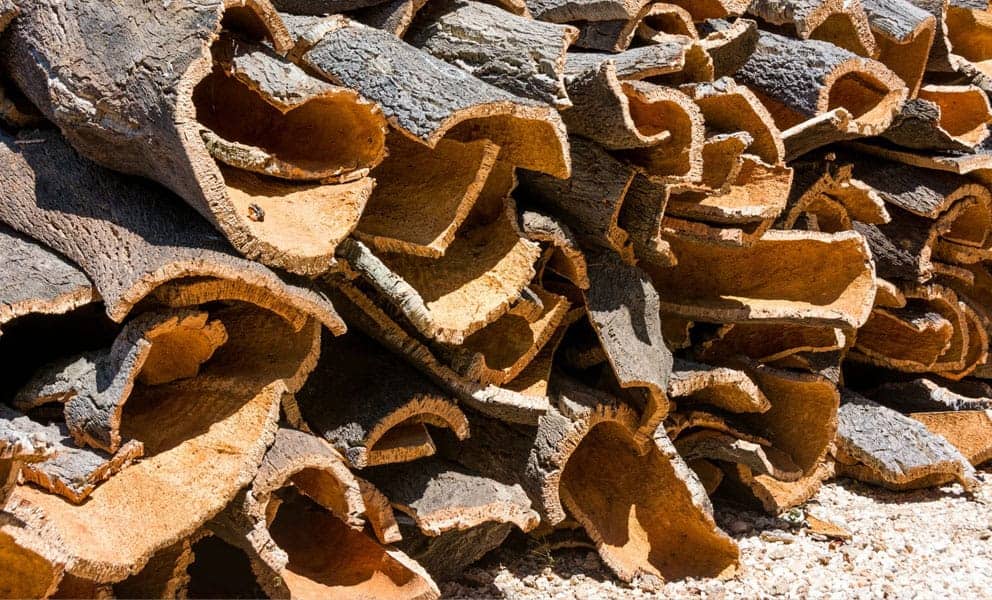
If you’ve read our previous blog posts, you’ll be well aware of its thermal, acoustic and flexible qualities. But where does cork actually come from?
In this post, we’ll answer exactly that to show just how eco-friendly cork really is, and where its natural qualities come from.
Cork material develops naturally in the bark of cork oak trees – or Quercus suber to use their Latin name. The cork itself is harvested by carefully stripping the bark from the trees, before separating the cork from the rough outer layer of the bark.
These trees make up cork oak forests or Montados. Montados are areas sparsely populated with trees where cork oak is predominant. On the other hand, cork oak forests are denser woods with a mixture of other species, alongside cork oak.
Montados, in particular, are some of the most biodiverse areas in the world. Trees are joined by countless plants and species, many of which are endangered according to UNESCO, like the Barbary Deer, Imperial Eagle and Iberian Lynx.
Nature aside, these forests are also highly important to the regions around them. Cork harvesting provides work and income for farmers and communities around them. Not to mention preventing desertification in otherwise arid areas.
Cork oak trees can have their bark stripped once they are fully mature – approximately 25 years old. But most importantly, they don’t need to be felled to harvest the cork. As long as the process is completed carefully, the cork-rich bark will regrow over the course of 8-14 years.
Even better, the cork-stripping process actually absorbs carbon dioxide – so it’s both sustainable and carbon negative.
This is a hot topic within the wine industry – and one worth addressing for anyone interested in cork more generally. Despite the name, synthetic corks aren’t actually made from cork. They’re manufactured from ethylene-vinyl acetate, using the name “cork” to refer to the stopper on a bottle rather than the material itself.
Now you know where synthetic cork comes from, it will come as no surprise that it’s only used for this specific purpose. Unlike real cork, it doesn’t carry any of the natural properties that make it insulative, nonpermeable and flexible. It also has a distinctly negative impact on the environment compared to real cork.
Absolutely. As a material, cork can be ground down and reused. That prevents wine corks from being reused as stoppers, but there are still endless possibilities for other means (more on this later!)
According to the world’s largest manufacturer of cork stoppers, around 164 million cork stoppers were recycled in 2020. That’s a significant increase from the previous years. However, it’s still only 2-3% of the total.
In the UK, used corks can be sent to Recorked for recycling. Or you can find your nearest collection partner through their online map to save on postage. However, cork is biodegradable, so it won’t stick around for decades or release toxins if it does go to landfill.
In terms of geography, cork predominantly comes from Mediterranean countries, like Portugal and Spain, which account for the vast majority of global cork production. Cork oak trees can also be found in Italy, Morocco, Tunisia, Algeria and France.
Here’s a breakdown of where cork comes from by country, according to APCOR:
Interestingly, understanding where cork comes from can explain many of its natural qualities too. While most trees have some amount of cork in their bark, cork oak trees have an especially thick layer, which enabled them to survive the extreme heat and drought of their Mediterranean environment.
As a result, it has a number of impressive properties, including thermal insulation, fire resistance and high durability. Its unique low-density composition with suberin cells also lends itself to sound insulation, flexibility and impermeability.
The natural qualities listed above make cork a highly useful material for a range of applications. No doubt the most familiar will be as a stopper for various beverages, including wine, which accounts for 60% of all cork production.
However, some lesser-known uses have included shuttlecocks for badminton, gaskets for car engines, floor and wall tiles, and even buoyant fishing floats. Nike has also created shoes made using recycled cork in its Plant Cork Pack collection.
Last, but certainly not least, is our powerful cork-based render and internal coating, which can be used on walls and roofs for waterproofing, thermal insulation and a range of other benefits. Cork granules are used in a sprayed cork coating, which adheres to a wide range of surfaces including brickwork, steel and existing render.
It can insulate your walls to cut your heating bills by 15%, absorb up to 38dB of noise for a more peaceful space, and even combat damp and mould. While other uses of cork showcase some of its great qualities, it’s hard to argue against our coatings being the best way to showcase the material!
Cork is a completely unique material, which provides an impressive, inimitable base for our natural cork render and internal insulation – SprayCork. With all of the qualities listed above, it’s no wonder so many people want to use SprayCork on their own domestic and commercial buildings.
To maintain the highest standards, SprayCork is only available through our network of approved applicators. Each contractor has been trained and tested in the application of SprayCork, so their customers can reap the rewards from cork’s natural properties.
Use our online contact form to tell us about your project, and we’ll put you in touch with one of our local approved applicators.
"*" indicates required fields